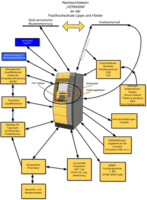
VernISiM: Vernetztes Intelligentes Sicherheitsmonitoring und -management

Concepts, methods and the design of a networked security-monitoring and -management system shall be realised within the scope of a holistic security concept for automated teller machines (ATMs).
In Germany, approx. 300 cases of manipulated or damaged ATMs for the purpose of cash theft were registered in 2006. Additionally, cases of manipulated payment terminals in stores were registered since 2007 where debit card data and personal identification numbers were disclosed. Besides material damage, substantial insecurities amongst the public accompanied by a loss of trust in security relevant technologies, affecting the individual’s privacy to a high degree, arise in the cash cycle.
Vernisim shall detect active and passive attacks on defined system components and, being designed as an Embedded System, is able to report an attack via an incorporated interface to a central analysis unit. In principle, methods for sensor signal processing and multi-sensor image processing and pattern recognition can contribute decisively to monitor cash dispense systems and, besides others, protect against so-called skimming security-relevant information.
An anomaly detection system which is to be designed will obtain measurement data from defined information sources and subsequently pre-process and analyse them. Based on sensor networks which generate processible information by sensor fusion methods, attacks or anomalies shall be detected during run-time. By means of a knowledge base, attack scenarios shall be detected and the causes of state changes analysed and interpreted. In this context the focus is on the decision whether the state anomalies are usual variations or intentional attacks on a system. In the scope of the planned project, the decision if and how an alarm is issued is based on the knowledge of the current state and by utilisation of historical data.
Additionally, general approaches for coupling human-machine-interactions with special respect to evidence theoretical and fuzzy classification concepts are evaluated to obtain statements about the quality of combined human and sensor information. It is planned to use certain steps of the project as examples for practically relevant process development in education and work on them in the scope of Bachelor and Master Theses as well as a cooperative doctorate.

